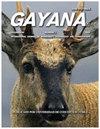智利斑点壁虎分岔尾生长的观察(鳞目,毛趾壁虎科)
IF 0.4
4区 生物学
Q3 Agricultural and Biological Sciences
引用次数: 0
摘要
许多蜥蜴(鳞蜥超目)的尾巴在完全或部分自动化后可以再生。然而,再生过程中有时会出现异常,例如,由于不完全自切而产生的伤口会长出一条或多条额外的尾巴。在这项工作中,我们描述了智利特有的壁虎Garthia gaudichaudii的额外尾巴(即分叉尾巴形成)的生长,在48天的圈养中达到7.1毫米的总长。本文章由计算机程序翻译,如有差异,请以英文原文为准。
Observation of the growth of a bifurcated tail in the Chilean Marked Gecko, Garthia gaudichaudii (Squamata, Phyllodactylidae)
Many lizards (Superorder Lepidosauria) can regenerate their tail after fully or partially autotomizing it. However, abnormalities in regeneration can sometimes occur, such as the growth of one or more additional tails from wounds produced, for example, by incomplete autotomy. In this work, we describe the growth of an additional tail (i
求助全文
通过发布文献求助,成功后即可免费获取论文全文。
去求助
来源期刊

Gayana
ZOOLOGY-
CiteScore
1.30
自引率
0.00%
发文量
5
审稿时长
>12 weeks
期刊介绍:
GAYANA is a scientific journal published by Universidad de Concepción, Chile. It is the modern version of Gayana Oceanología and Gayana Zoología. Therefore its numeration starts at volume 63(1).
GAYANA covers all aspects of zoology and oceanographic research. It is structured in five sections, defined by subject or discipline: Ecology, Biodiversity and Taxonomy, Earth Sciences, Evolutionary, and Applied Biology and Environmental Biology. Each section is in charge of an editor who receives and manages the manuscripts sent for evaluation in close collaboration with the editorial board.
 求助内容:
求助内容: 应助结果提醒方式:
应助结果提醒方式:


